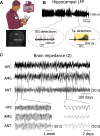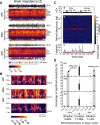Impedance Rhythms in Human Limbic System
- PMID: 37620157
- PMCID: PMC10538585
- DOI: 10.1523/JNEUROSCI.0241-23.2023
Impedance Rhythms in Human Limbic System
Abstract
The impedance is a fundamental electrical property of brain tissue, playing a crucial role in shaping the characteristics of local field potentials, the extent of ephaptic coupling, and the volume of tissue activated by externally applied electrical brain stimulation. We tracked brain impedance, sleep-wake behavioral state, and epileptiform activity in five people with epilepsy living in their natural environment using an investigational device. The study identified impedance oscillations that span hours to weeks in the amygdala, hippocampus, and anterior nucleus thalamus. The impedance in these limbic brain regions exhibit multiscale cycles with ultradian (∼1.5-1.7 h), circadian (∼21.6-26.4 h), and infradian (∼20-33 d) periods. The ultradian and circadian period cycles are driven by sleep-wake state transitions between wakefulness, nonrapid eye movement (NREM) sleep, and rapid eye movement (REM) sleep. Limbic brain tissue impedance reaches a minimum value in NREM sleep, intermediate values in REM sleep, and rises through the day during wakefulness, reaching a maximum in the early evening before sleep onset. Infradian (∼20-33 d) impedance cycles were not associated with a distinct behavioral correlate. Brain tissue impedance is known to strongly depend on the extracellular space (ECS) volume, and the findings reported here are consistent with sleep-wake-dependent ECS volume changes recently observed in the rodent cortex related to the brain glymphatic system. We hypothesize that human limbic brain ECS changes during sleep-wake state transitions underlie the observed multiscale impedance cycles. Impedance is a simple electrophysiological biomarker that could prove useful for tracking ECS dynamics in human health, disease, and therapy.SIGNIFICANCE STATEMENT The electrical impedance in limbic brain structures (amygdala, hippocampus, anterior nucleus thalamus) is shown to exhibit oscillations over multiple timescales. We observe that impedance oscillations with ultradian and circadian periodicities are associated with transitions between wakefulness, NREM, and REM sleep states. There are also impedance oscillations spanning multiple weeks that do not have a clear behavioral correlate and whose origin remains unclear. These multiscale impedance oscillations will have an impact on extracellular ionic currents that give rise to local field potentials, ephaptic coupling, and the tissue activated by electrical brain stimulation. The approach for measuring tissue impedance using perturbational electrical currents is an established engineering technique that may be useful for tracking ECS volume.
Keywords: brain impedance; circadian rhythm; extracellular space; implantable neural stimulators; long-term data; sleep.
Copyright © 2023 the authors.
Conflict of interest statement
Unrelated to this research, G.A.W., B.H.B., J.V.G., and B.N.L are named inventors for intellectual property developed at Mayo Clinic and licensed to Cadence Neuroscience. G.A.W. has licensed intellectual property developed at Mayo Clinic to NeuroOne. B.N.L., G.A.W., and N.M.G. are investigators for the Medtronic Deep Brain Stimulation Therapy for the Epilepsy Post-Approval Study. V.K. consults for Certicon. I.B. has received compensation from an internship with Cadence Neuroscience for work unrelated to the current work. Mayo Clinic has received research support and consulting fees on behalf of G.A.W., B.N.L., and B.H.B. from Cadence Neuroscience, UNEEG Medical, NeuroOne, Epiminder, Medtronic, and Philips Neuro. P.C. has received research grant support from Neuronetics, NeoSync, and Pfizer; grant in kind (equipment support) from Assurex, MagVenture, and Neuronetics; and served as a consultant for Engrail Therapeutics, Myriad Neuroscience, Procter & Gamble, and Sunovion. T.D. is a consultant for Synchron, is on the advisory board of Cortec Neuro, is a shareholder collaborator of Bioinduction, and a shareholder director of Amber Therapeutics. T.D. has patents in the field of impedance measurement instrumentation and its application for epilepsy seizure prediction. All the other authors declare no competing financial interests.
Figures







References
-
- Bard AJ, Faulkner LR (2001) Electrochemical methods: fundamentals and applications. 2nd ed. New York: Wiley.
Publication types
MeSH terms
Grants and funding
LinkOut - more resources
Full Text Sources
